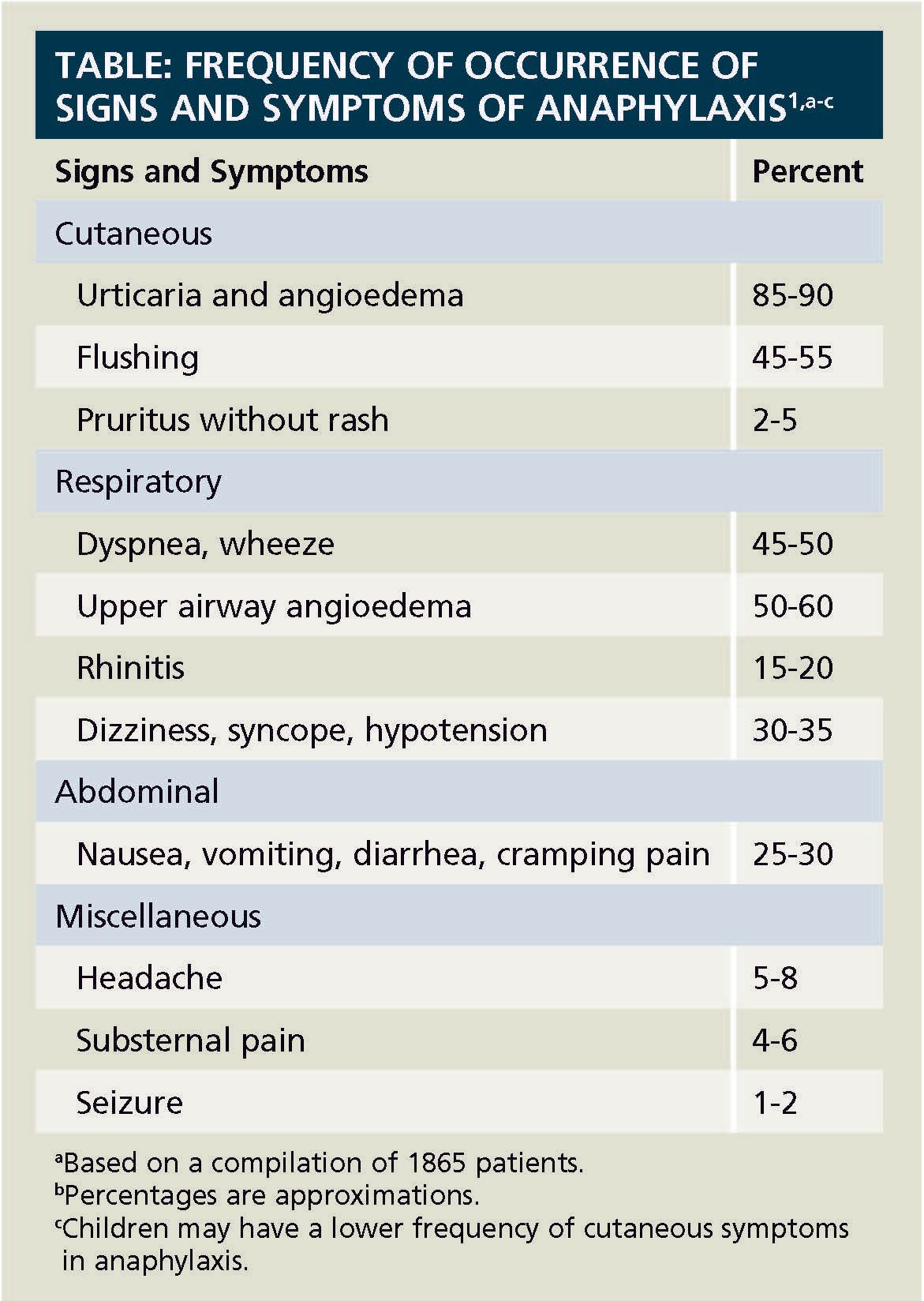Publication
Article
Pharmacy Times
Considerations for the Pharmacist About Anaphylaxis and Epinephrine Auto-Injectors
Author(s):
This article was sponsored by Mylan Specialty.
Please see Important Safety Information below and full Prescribing Information and Patient Information.
Anaphylaxis is an acute, severe, life-threatening systemic allergic reaction caused by the sudden release of mast cell and basophil mediators.1 Triggers for anaphylactic reactions may include foods (eg, peanuts, tree nuts, fish, shellfish, cow’s milk, soy, eggs), natural rubber latex, medications (eg, general anesthesia, penicillin), and insect stings.1,3 The onset of the anaphylactic reaction generally occurs within seconds or minutes of exposure to the injected or ingested allergen, although the timing of the emergence of signs and symptoms varies from person to person. Generally, the signs and symptoms of anaphylaxis affect the skin and the respiratory, circulatory, and gastrointestinal systems; the most serious symptoms are low blood pressure, difficulty breathing, and loss of consciousness (Table).1,3,4 An anaphylactic reaction can involve upper or lower airway obstruction or both; patients may have laryngeal edema that they describe as a “lump” in the throat, or a bronchial obstruction that may manifest as wheezing or a feeling of tightness in the chest. A characteristic skin feature is the appearance of well-circumscribed cutaneous wheals that are intensely pruritic and can be disseminated or localized.3 The overall incidence of anaphylaxis is estimated to be between 1% and 2%.5 Of note, up to 20% of patients with anaphylaxis will experience a biphasic reaction—an initial reaction followed by a second reaction.6 The reported time to onset of the second reaction ranges from 1 to 78 hours; however, most occur within 8 hours.7 Protracted severe anaphylaxis can last up to 32 hours despite treatment.1

As anaphylaxis is potentially fatal, immediate symptom recognition and treatment are required.3 According to joint guidelines from the American Academy of Allergy, Asthma & Immunology; the American College of Allergy, Asthma & Immunology; and the Joint Council of Allergy, Asthma and Immunology, injectable epinephrine is the treatment of choice.1 Guidelines from the National Institute of Allergy and Infectious Diseases (NIAID) also recommend the use of injectable epinephrine as first-line treatment for anaphylaxis. If there is a suboptimal response to epinephrine or if symptoms progress, a repeat dose of epinephrine is recommended over the use of other therapies. Antihistamines are commonly used in the treatment of anaphylaxis; however, the use of antihistamines alone may increase the risk of progression toward a lifethreatening reaction.2 All patients who have had anaphylactic reactions should be counseled on allergen avoidance measures.1 NIAID guidelines recommend that patients carry 2 doses of epinephrine with them at all times.2
About EpiPen® Auto-Injector
EpiPen® (epinephrine injection) Auto-Injector and EpiPen Jr® (epinephrine injection) Auto-Injector are indicated in the emergency treatment of allergic reactions (type I) including anaphylaxis to stinging insects (eg, order Hymenoptera, which includes bees, wasps, hornets, yellow jackets, and fire ants) and biting insects (eg, triatoma, mosquitos), allergen immunotherapy, foods, drugs, diagnostic testing substances (eg, radiocontrast media), and other allergens, as well as idiopathic anaphylaxis or exercise-induced anaphylaxis.8
There are no absolute contraindications to the use of epinephrine in a life-threatening situation. Adverse reactions include transient, moderate anxiety; apprehensiveness; restlessness; tremor; weakness; dizziness; sweating; palpitations; pallor; nausea and vomiting; headache; and/or respiratory difficulties. Arrhythmias, including fatal ventricular fibrillation, have been reported in patients with underlying cardiac disease or who are taking certain drugs (ie, cardiac glycosides or diuretics). Rapid rises in blood pressure have produced cerebral hemorrhage, particularly in elderly patients with cardiovascular disease. Angina may occur in patients with coronary artery disease.8
The EpiPen® Auto-Injector is supplied as a 2-pack carton (ie, 2 auto-injectors) that also includes 1 training device and is available in 2 different doses, 0.3 mg or 0.15 mg. The 0.3-mg dose is intended for patients who weigh 66 pounds or more, whereas the 0.15-mg dose is intended for patients who weigh between 33 and 66 pounds.8
According to the FDA Therapeutic Equivalence Evaluation Code (Orange Book), EpiPen®Auto-Injector and EpiPenJr® Auto-Injector have been assigned a BX equivalence code and are not therapeutically equivalent to other epinephrine auto-injector products. The BX code is assigned when there are known or potential bioequivalence problems or when there are insufficient data to support bioequivalence. By contrast, the AB code is assigned when bioequivalence requirements have been met; AB-rated products are considered therapeutically equivalent to other products.9 Although generic substitution laws vary by state, many states allow generic substitution based on therapeutic equivalency (AB rating) as listed in the Orange Book. Pharmacists who dispense epinephrine to patients with a history of anaphylaxis should be aware that there are no AB-rated generic equivalents to EpiPen® Auto-Injector and EpiPen Jr® Auto-Injector.10
Role of the Pharmacist
EpiPen® Auto-Injector was approved by the FDA in 1987 and has a long history of use.9 Other epinephrine auto-injector products use the same drug and dosage but a different delivery device.11-13 It is important to note that patients will often have received training on a particular prescribed epinephrine device; therefore, if a different device is dispensed, additional training may be warranted.
Patients may present to the pharmacy with a prescription for multiple EpiPen 2-Pak® cartons so that they have 2 doses of epinephrine available in several locations (eg, home, car, office). Up to 20% of patients with anaphylaxis will experience a biphasic reaction, and a second dose of epinephrine may be needed if symptoms progress or if there is a suboptimal response to epinephrine.2,6 Pharmacists should consider keeping sufficient stock on hand to accommodate the dispensing of multiple EpiPen 2-Pak® cartons. It also may be necessary at times to dispense one EpiPen 2-Pak® carton with the remainder of prescription dispensed another day. Pharmacists should let patients know when they can come back for the remainder of the prescription, and remind patients of the importance of coming back so that they have multiple EpiPen 2-Pak® cartons to keep in locations where they may be needed. When processing the pharmacy claim, it is important to note that Medi-Span has designated the EpiPen 2-Pak® carton as a 1-day supply.14
Counseling topics for patients with anaphylaxis include avoiding known allergens and recognizing the symptoms of a life-threatening allergic reaction. Patients should also be informed about the potential for a biphasic reaction that could result in a need for multiple epinephrine injections. Patients should receive training on the use of the epinephrine auto-injector and should also strongly consider training family and friends on the use of the auto-injector, in the event that assistance is needed. Patients should also be advised that using an auto-injector is not a substitute for emergency medical attention. Following usage of the auto-injector, patients should make a follow-up appointment with their allergist/immunologist.1 Other counseling points should include storing epinephrine auto-injectors properly and keeping epinephrine auto-injectors on hand wherever they may be needed (eg, home, car, office). Importantly, patients should be instructed to regularly check the expiration date on all epinephrine auto-injectors. By counseling patients on avoidance of known allergens, proper device usage, prompt symptom recognition, and appropriate device storage, pharmacists can help improve outcomes during emergency medical situations involving anaphylaxis.
INDICATIONS
EpiPen® (epinephrine injection) 0.3 mg and EpiPen Jr® (epinephrine injection) 0.15 mg Auto-Injectors are indicated in the emergency treatment of type 1 allergic reactions, including anaphylaxis, to allergens, idiopathic and exercise-induced anaphylaxis, and in patients with a history or increased risk of anaphylactic reactions. Selection of the appropriate dosage strength is determined according to body weight.
IMPORTANT SAFETY INFORMATION
EpiPen® (epinephrine injection) 0.3 mg and EpiPen Jr® (epinephrine injection) 0.15 mg Auto-Injectors should only be injected into the anterolateral aspect of the thigh. Do not inject intravenously, into buttock, or into digits, hands, or feet. Epinephrine should be used with caution in patients with certain heart diseases, and in patients who are on drugs that may sensitize the heart to arrhythmias, because it may precipitate or aggravate angina pectoris and produce ventricular arrhythmias. Arrhythmias, including fatal ventricular fibrillation, have been reported in patients with underlying cardiac disease or taking cardiac glycosides or diuretics.
Patients with certain medical conditions or who take certain medications for allergies, depression, thyroid disorders, diabetes, and hypertension, may be at greater risk for adverse reactions. Other adverse reactions include anxiety, apprehensiveness, restlessness, tremor, weakness, dizziness, sweating, palpitations, pallor, nausea and vomiting, headache, and/or respiratory difficulties.
EpiPen® and EpiPen Jr® are intended for immediate administration as emergency supportive therapy only and are not intended as a substitute for immediate medical or hospital care. In conjunction with the administration of epinephrine, the patient should seek immediate medical or hospital care. More than two sequential doses of epinephrine should only be administered under direct medical supervision.
You are encouraged to report negative side effects of prescription drugs to the FDA. Visit www.fda.gov/medwatch or call 1-800-FDA-1088.
For additional information, please contact Mylan Specialty L.P. at 800-395-3376.
EpiPen®, EpiPen Jr®, EpiPen 2-Pak®, and EpiPen Jr 2-Pak® are registered trademarks of Mylan Inc. licensed exclusively to its wholly-owned subsidiary, Mylan Specialty L.P. All rights reserved.
References
- Lieberman P, Nicklas RA, Oppenheimer J, et al. The diagnosis and management of anaphylaxis practice parameter: 2010 update. J Allergy Clin Immunol. 2010;126(3):477-480.
- Boyce JA, Assa’ad A, Burks AW, et al; NIAIDSponsored Expert Panel. Guidelines for the diagnosis and management of food allergy in the United States: report of the NIAID-sponsored expert panel. J Allergy Clin Immunol. 2010;126(6 suppl):S1-S58.
- Austen K. Allergies, anaphylaxis, and systemic mastocytosis. In: Longo DL, Fauci AS, Kasper DL, Hauser SL, Jameson J, Loscalzo J, eds. Harrison’s Principles of Internal Medicine. 18th ed. New York, NY: McGraw-Hill; 2012. http://accesspharmacy.mhmedical.com.proxy.libraries.rutgers.edu/content.aspxbookid=331&Sectionid=40727118. Accessed May 5, 2014.
- Anaphylaxis: tips to remember. American Academy of Allergy, Asthma & Immunology website. http:// www.aaaai.org/conditions-and-treatments/library/ata- glance/anaphylaxis.aspx. Accessed March 26, 2015.
- Simons FE, Ardusso LR, Bilo MB, et al. World allergy organization guidelines for the assessment and management of anaphylaxis. World Allergy Organ J. 2011;4(2):13-37.
- Stark BJ, Sullivan TJ. Biphasic and protracted anaphylaxis. J Allergy Clin Immunol. 1986;78(1, pt 1):76-83.
- Lieberman P. Biphasic anaphylactic reactions. Ann Allergy Asthma Immunol. 2005;95(3):217-226.
- EpiPen/EpiPen Jr Auto-Injector [prescribing information]. Morgantown, WV: Mylan Specialty LP; 2014.
- FDA Center for Drug Evaluation and Research. Approved Drug Products With Therapeutic Equivalence Evaluations. 35th ed. Silver Spring, MD: US Department of Health and Human Services; 2015.
- Generic drug substitution requires pharmacist attention to ensure compliance with state laws and regulations. National Association of Boards of Pharmacy Newsletter. 2013:42(6):135-140.
- Adrenaclick [patient information]. Horsham, PA: Amedra Pharmaceuticals LLC; 2013.
- Auvi-Q [prescribing information]. Bridgewater, NJ: sanofi-aventis US LLC; 2014.
- EpiPen/EpiPen Jr Auto-Injector [patient information]. Morgantown, WV: Mylan Specialty LP; 2014.
- Medi-Span Price Rx. AWP and WAC pricing for EpiPen 2-Pak Injection Device 0.3 mg/0.3 mL. www.pricerx.medispan.com/ProductInfoReport.aspxid= 49502050002. Accessed February 12, 2015.
EPI-2015-0403








